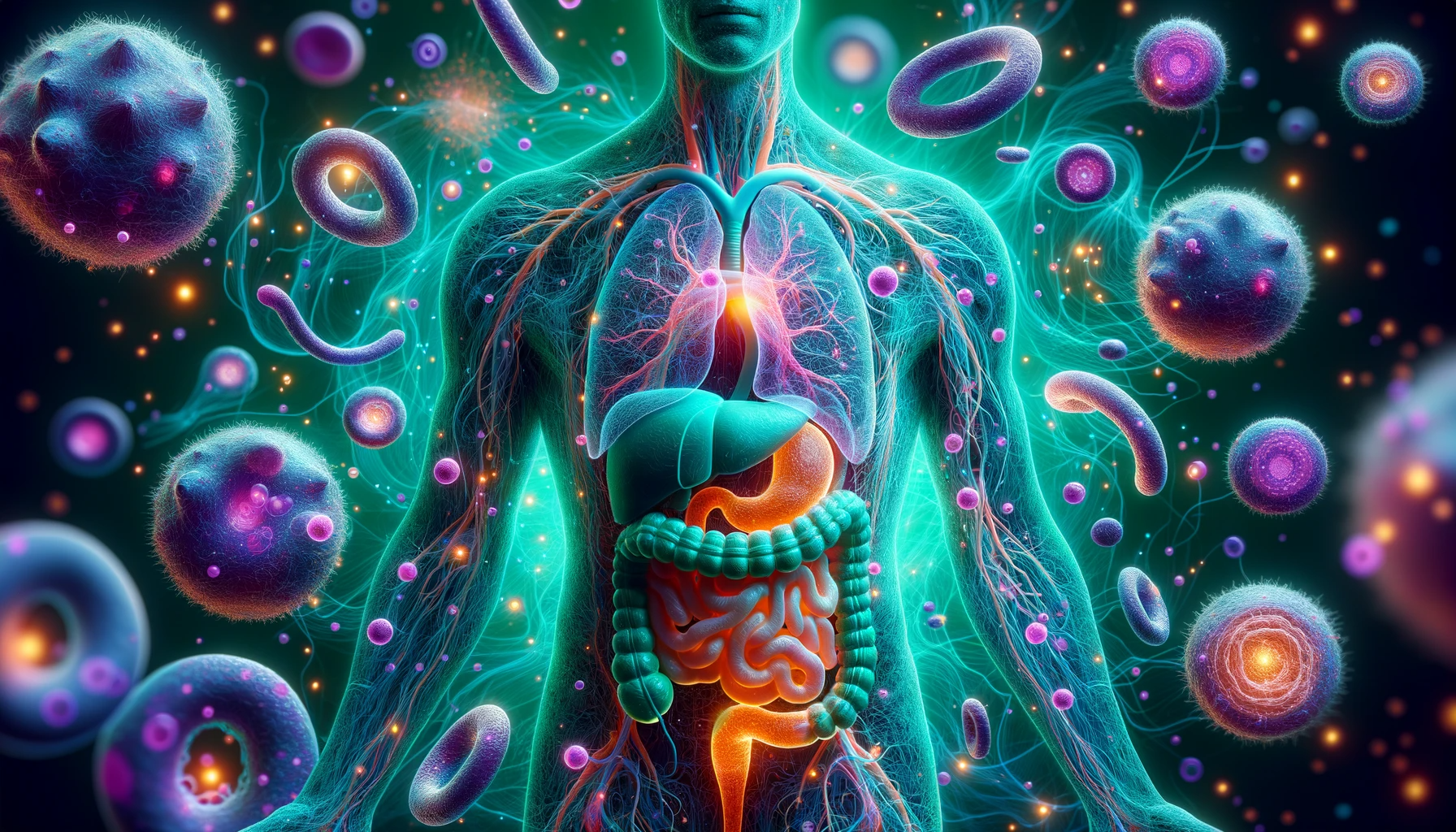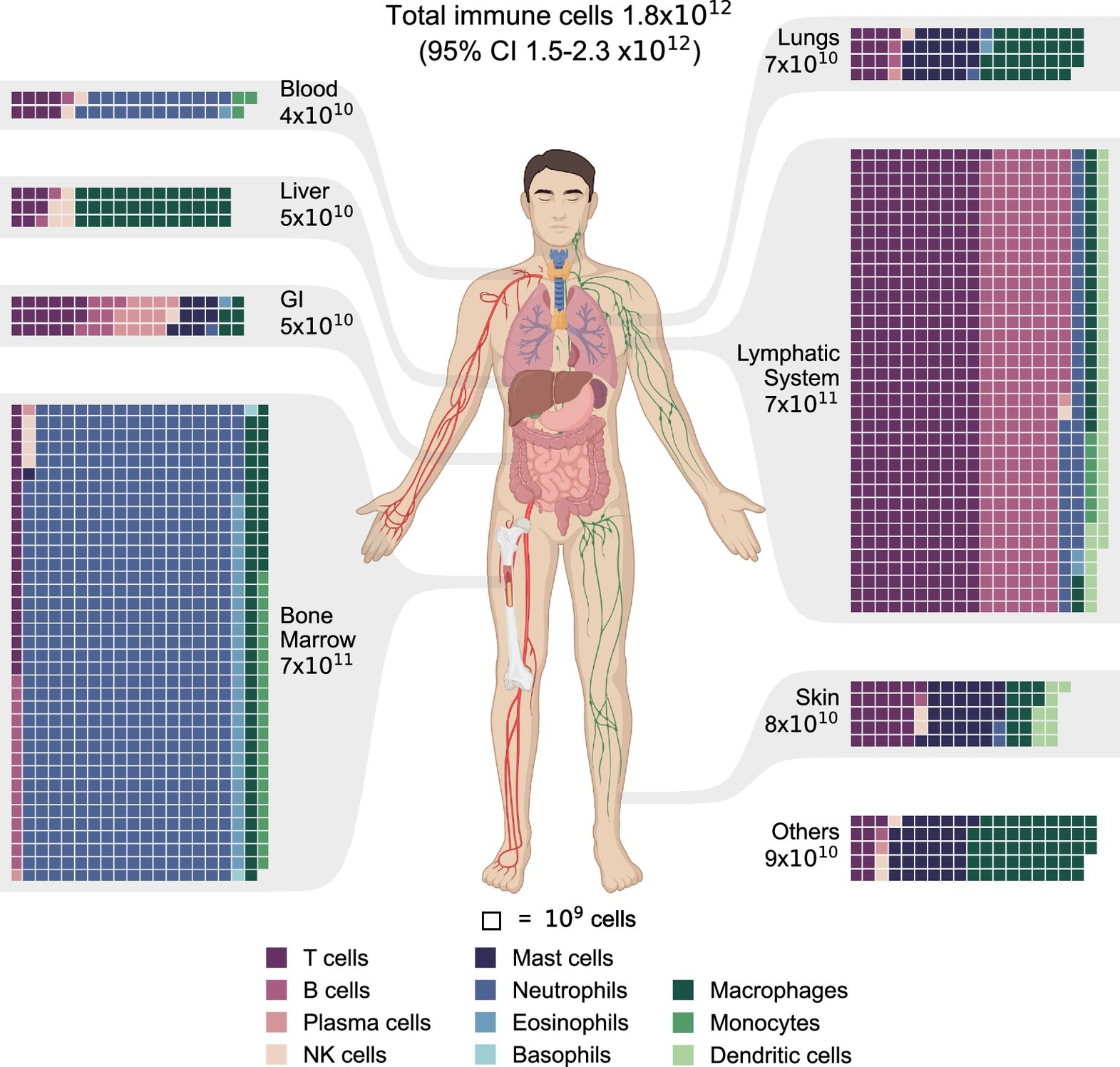The immune system's intricate cellular network is vital for health, yet understanding its distribution remains challenging due to cellular diversity and past study limitations. Existing research, often narrow in focus and methodology, lacks comprehensive human-specific data, prompting debates on topics like the most immunogenic organ. Further research is needed to clarify immune cell distribution, reconcile study discrepancies, and deepen insights into immune functionality in humans.
 Study: The total mass, number, and distribution of immune cells in the human body. Image Credit: Created with the assistance of DALL·E 3
Study: The total mass, number, and distribution of immune cells in the human body. Image Credit: Created with the assistance of DALL·E 3
Mapping the Human Immune System
The present study thoroughly maps the human immune system, categorizing cells into lymphoid and myeloid groups, using a healthy young male as a reference for establishing baseline cell densities. The research is anchored in three methodologies: an extensive literature review, high-resolution multiplexed imaging, and novel methylation-based deconvolution. The review updates historical data to modern cell density estimates, considering unique tissue characteristics and using advanced methods like flow cytometry for relative abundance data. Tissues and organs are classified by anticipated immune cell presence, forming a systematic structure for analysis.
Multiplexed imaging offers detailed tissue snapshots, identifying various immune cells with precision. This approach, analyzing numerous molecular markers concurrently, presents an inclusive picture of immune populations. Meanwhile, methylation-based deconvolution deciphers the epigenetic footprints unique to each cell type, unraveling the proportions and absolute numbers of immune cells in tissues.
Findings on Immune Cell Density and Distribution
The present study uncovers detailed insights into the density and spread of immune cells in human tissues. The data, derived from a thorough literature survey, denotes the density of various cell types in tissues grouped by similar composition and roles. Lymphatic systems and bone marrow record the highest densities, being primarily composed of immune cells, while epithelial organs maintain a significantly lower density.
 The distribution of immune cells in the human body. Estimates of immune cell populations by cell type and tissue grouped by primary tissues and systems. The tissues are displayed via a chart of the human body. A waffle chart depicts the distribution of immune cells in each tissue, with each square representing a population of 109 cells. To facilitate the presentation, the populations were rounded to multiples of 109. The total population of each tissue is shown with one significant digit. Throughout all the figures, cell types are color-coded for ease of reference. GI = gastrointestinal tract. Other tissues and organs include the brain, heart, adipose tissue, skeletal muscles, kidneys, etc.
The distribution of immune cells in the human body. Estimates of immune cell populations by cell type and tissue grouped by primary tissues and systems. The tissues are displayed via a chart of the human body. A waffle chart depicts the distribution of immune cells in each tissue, with each square representing a population of 109 cells. To facilitate the presentation, the populations were rounded to multiples of 109. The total population of each tissue is shown with one significant digit. Throughout all the figures, cell types are color-coded for ease of reference. GI = gastrointestinal tract. Other tissues and organs include the brain, heart, adipose tissue, skeletal muscles, kidneys, etc.
Distinct patterns emerge in the distribution of specific immune cells. Macrophages, T, and B cells vary greatly across tissues, while plasma cells and eosinophils are largely confined to the gastrointestinal tract. Intriguingly, adipose and skeletal muscle tissues, accounting for roughly 75% of the body's cellular mass, house a mere 0.2% of the total cell count, a fact ascribed to their larger cell size.
In a novel approach, the study melds tissue-specific immune cell densities with organ mass in a standard human model, approximating the entire count of immune cells in various tissues at around 1.8 × 1012. Most are situated in the bone marrow and lymphatic system, with diverse immune cell types dispersed in differing ratios across each organ system.
In-depth tissue analysis reveals a heterogeneous immune cell makeup. The bone marrow is filled with neutrophils, and the lymphatic system abounds with lymphocytes. Other tissues, such as the gastrointestinal tract, skin, and lungs, host considerable mast cell and macrophage communities.
The lymphatic system is the primary habitat for T cells, B cells, and dendritic cells, while the bone marrow harbors a variety of other cells. Conversely, mast cells, NK cells, and macrophages are largely tissue-resident, not predominating in any specific system.
These estimates were validated using a methylation atlas-based deconvolution approach, confirming the literature-based findings, particularly for lymphocytes. However, some discrepancies were noted, especially for granulocytes.
The study also ventured into uncharted territory by estimating the mass of these immune cells, a feat accomplished by aggregating data on cell sizes and volumes. The total immune cell mass in the body is estimated at 1.2 kg. The distribution by cell type reveals a significant deviation from their distribution by number, primarily due to variations in cell sizes. For instance, macrophages account for a substantial portion of the total immune cell mass due to their larger size.
Furthermore, the research concludes these findings to other demographics, using a reference female and child. Interestingly, cell type and tissue distribution remain consistent across different sexes and ages, suggesting a standardized pattern in immune cell distribution throughout the human body.
Key Takeaways and Implications
To summarize, the study offered new estimates on immune cell count, mass, and distribution in humans, challenging the belief that most reside in the gut; instead, primary sites are bone marrow, lymph nodes, and spleen. It highlighted the gut's role in antibody production and the liver's immunological functions. Validation was achieved through multiple analyses, confirming the findings' reliability. The research also considered variations due to sex, age, and health status, noting the immune system's dynamic nature. Despite certain limitations and uncertainties, the study illuminates the complexity of immune cell distribution, underscoring the need for comprehensive data and advanced methodologies.